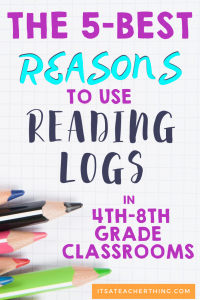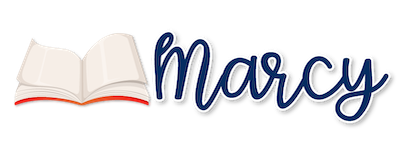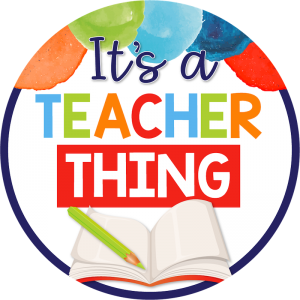Reading Logs are a foundational tool in my sixth grade classroom. Some teachers cringe at the term “Reading Log”, but I firmly believe that if we can rethink and restructure how reading logs are used, there might not be such an aversion to what I consider to be an essential part of my curriculum. With this in mind, I set out to create my own to meet my needs. I hope to help you discover easy ways to make your reading logs work for you.
#1. Reading Response Logs can be versatile
First, what I call a reading log is really reading response. I created a reading log that has versatility. By this I mean that I wanted 4 entries on a log (2 on each side–enough for the week) with the area for a prompt left blank or filled with a general response prompt. I also have a version with one entry on each side for times when more writing is needed.
Here’s an example of what my Reading Response Log often looks like in action:
I may be targeting setting in our reading class, but I also want to carry this idea of the importance of setting over into social studies. One prompt could be something like this:
- What is the main setting in your independent reading novel? Does this setting have an impact on the events in the story? Why or why not?
Then in the section below this, my prompt might be the following:
- Thinking of what we’ve learned about early humans, describe one way that setting impacted the way they lived.
Relating a concept across subject areas is POWERFUL! The fact that I’ve made my reading response log so flexible helps students make deeper connections in their reading.
I LOVE this adaptability because I can change up my target content area on a weekly basis. That means I may have scores for social studies, reading, science, and writing on one log!
You can see an image of both sides of my Reading Response Logs (find them here). Since the Logs are adaptable, I can tailor prompts to the topic of my choosing. I do like students to be aware of their reading minutes per week, so I include this section, but I also have versions without this feature.
2. Reading Response Logs allow for frequent teacher modeling
I spend the first month of school using the response log religiously. I start the year with a class read aloud novel, which is one of the best things I’ve done as a teacher because the entire class has familiarity with the text. It can be used to model responding to literature.
For the first three weeks, I write a response to a prompt about our read aloud text and students copy it. Then below, on another response entry, students answer the same question I used for the read aloud text, except this time they’re responding based on their independent reading.
This can be done with any content area where the same text is used. In a short time, you can simply write the prompt, share an example, and students respond with their individual text in mind. It pays to mentor early and often at the beginning of the year.
3. Student knowledge and understanding is easy to assess
Once students understand the structure of the response log, it becomes a primary mode for sharing their knowledge and ideas. The entries are either 2-3 sentences, which is very often all that is needed to show understanding, or up to an entire page if that’s what you believe is appropriate to the task. Quite often, much of my grading for the week is this one page because it addresses more than one standard and frequently more than one subject area. Check out this blog post that goes into more detail about my version of the Reading Log.
4. Target many standards at one time
During the first month of school, I model essential skills about 2-4 times a week on the reading response log. Here’s a list of skills that come up repeatedly:
- Rephrasing the question in a response
- Capitalizing and underlining titles
- Analyzing the prompt for all that it is asking
- Noticing the verbs in the prompt
- Using text evidence as support
- How to cite text evidence
- Since I begin my reading lessons with plot, setting, character, and head towards theme, these are often the focus of my reading response prompts
- Using punctuation at the end of a sentence
- Types of sentences
- Commas in a series and around extra non-essential information
- Lengthening sentences for complexity
- Checking to see if the prompt has been answered
- How to read with a specific target in mind
- How to notice if a book is not “just right”
- Any grammar that comes up regularly like adjective, proper nouns, verb tense, etc.
It is really endless. Having a blank prompt area allows the teacher to reflect on the academic work from the week and to quickly focus on an area in which students need more help. You may also decide to push on to new concepts. The wonderful thing is that I don’t need to find other student work or teacher pages/units to make this decision. It’s all right there on the response log.
5. Reading Logs simplify differentiation
Simplify Differentiation? Indeed! I created my Reading Log with the understanding that all students don’t fit one mold. A few ways I’ve differentiated the log so all students can succeed include the following:
- more writing space
- reduced workload (fewer prompts)
- no page recording area
- no time recording area
- pre-written sentence starters to eliminate frustration
- pre-written sentence stems to move thinking along
- pre-exposure to the prompts for the week
- empowering a student by asking them select a weekly prompt from a limited choice
- choosing prompts that relate to mini lessons for the week
- choosing prompts that connect to prior knowledge
- front loading students with knowledge to reduce frustration
Having different versions of the reading log ready-to-go is a lifesaver (and time saver!). Since the look and structure of the log is similar every week, this quickly creates a level of comfort and reduces frustration. (Of course I do change it up later in the year, but this is another blog post).
Find more information in this blog post on creating independent reading programs for your upper elementary and middle school students.
I save time by having categorized reading response questions at my fingertips for use on reading logs. I’ve included the reading response prompts as lists in my Reading Response unit, but I also like having reading response prompts on rings and categorized by character, setting, author’s purpose, interpretation, etc. This way if a student has shown that they are ready for more independence, I can ask them to grab the character prompts and select one that they might prefer. The student is in charge of writing the prompt on the log.
My reading response questions include over 150 categorized prompts which are labeled and easily identifiable. These are also great for book clubs. See this blog post here for more on how to run book clubs in your classroom.
If you’re looking for versatile reading logs to use throughout the year, you can find the ready-to-use Reading Response Logs here.

In my next blog post, I’ll discuss how to use the response pages for social studies or science.
Pin this blog post for a later!

Happy Reading!




Leave a Reply